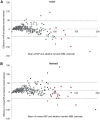Clinical perspectives on the menstrual pictogram for the assessment of heavy menstrual bleeding
- PMID: 36382010
- PMCID: PMC9651972
- DOI: 10.1093/hropen/hoac048
Clinical perspectives on the menstrual pictogram for the assessment of heavy menstrual bleeding
Abstract
Heavy menstrual bleeding (HMB) has an estimated prevalence of 18-32% but is known to be under-reported due to poor recognition and estimation of menstrual blood loss (MBL). HMB can negatively impact quality of life, affecting social interactions, work productivity and sexual life. Abnormal menstrual bleeding may have an underlying structural or systemic cause, such as endometrial and myometrial disorders; however, for some, there is no identified pathological cause. Several methods are available for assessing MBL, including the alkaline hematin (AH) method and the menstrual pictogram (MP). The AH method is considered to be the most accurate way to monitor MBL; however, it is associated with inconvenience and expense, therefore limiting its value outside of research. The MP requires the user to select an icon from a chart that reflects the appearance of a used sanitary product; the icon is associated with a blood volume that can be used to determine MBL. Validation studies have demonstrated that the results of the MP and AH method are well correlated, showing that the MP can measure MBL with sufficient accuracy. Additionally, the MP is more convenient for users, less expensive than the AH method, may be used in regions where the AH method is unavailable and may also be used as part of a digital application. Overall, the MP offers a convenient approach to monitor MBL both in research and clinical practice settings.
Keywords: abnormal uterine bleeding; alkaline hematin method; heavy menstrual bleeding; menstrual blood loss; menstrual pictogram; uterine fibroids.
© The Author(s) 2022. Published by Oxford University Press on behalf of European Society of Human Reproduction and Embryology.
Figures


Similar articles
-
A systematic review of methods to measure menstrual blood loss.BMC Womens Health. 2018 Aug 22;18(1):142. doi: 10.1186/s12905-018-0627-8. BMC Womens Health. 2018. PMID: 30134884 Free PMC article.
-
Validation of the menstrual pictogram in women with leiomyomata associated with heavy menstrual bleeding.Reprod Sci. 2013 Jun;20(6):680-7. doi: 10.1177/1933719112463252. Epub 2012 Nov 27. Reprod Sci. 2013. PMID: 23188490 Clinical Trial.
-
Pictorial methods to assess heavy menstrual bleeding in research and clinical practice: a systematic literature review.BMC Womens Health. 2020 Feb 10;20(1):24. doi: 10.1186/s12905-020-0887-y. BMC Womens Health. 2020. PMID: 32041594 Free PMC article.
-
Validation of a menstrual pictogram and a daily bleeding diary for assessment of uterine fibroid treatment efficacy in clinical studies.J Patient Rep Outcomes. 2020 Nov 13;4(1):97. doi: 10.1186/s41687-020-00263-0. J Patient Rep Outcomes. 2020. PMID: 33185783 Free PMC article.
-
Evaluation of menstrual blood loss (MBL) by self-perception and pictorial methods and correlation to uterine myometrial pathology.Arch Gynecol Obstet. 2024 Dec;310(6):3121-3129. doi: 10.1007/s00404-024-07729-2. Epub 2024 Nov 30. Arch Gynecol Obstet. 2024. PMID: 39614907
Cited by
-
Contemporary evaluation of women and girls with abnormal uterine bleeding: FIGO Systems 1 and 2.Int J Gynaecol Obstet. 2023 Aug;162 Suppl 2(Suppl 2):29-42. doi: 10.1002/ijgo.14946. Int J Gynaecol Obstet. 2023. PMID: 37538019 Free PMC article.
-
Abnormal uterine bleeding: The well-known and the hidden face.J Endometr Uterine Disord. 2024 Jun;6:100071. doi: 10.1016/j.jeud.2024.100071. Epub 2024 Apr 1. J Endometr Uterine Disord. 2024. PMID: 38764520 Free PMC article.
-
Evaluating the psychometric measurement properties of patient-reported outcome measures for uterine fibroids using the Consensus-based Standards for the selection of health Measurement Instruments (COSMIN) guidelines: a systematic review.BMJ Open. 2025 Jul 28;15(7):e087443. doi: 10.1136/bmjopen-2024-087443. BMJ Open. 2025. PMID: 40721265 Free PMC article.
-
The Changes in Menstrual and Menstrual-Related Symptoms among Japanese Female University Students: A Prospective Cohort Study from Three Months to Nine Months after Admission.Healthcare (Basel). 2023 Sep 15;11(18):2557. doi: 10.3390/healthcare11182557. Healthcare (Basel). 2023. PMID: 37761754 Free PMC article.
-
Association between Patients' Self-Judgement, Coagulated Menstrual Blood, and Menorrhagia: Results from a Questionnaire Survey and Blood Test Analysis.Medicina (Kaunas). 2023 May 1;59(5):874. doi: 10.3390/medicina59050874. Medicina (Kaunas). 2023. PMID: 37241106 Free PMC article.
References
-
- Barr F, Brabin L, Agbaje O.. A pictorial chart for managing common menstrual disorders in Nigerian adolescents. Int J Gynaecol Obstet 1999;66:51–53. - PubMed
-
- Bitzer J, Serrani M, Lahav A.. Women’s attitudes towards heavy menstrual bleeding, and their impact on quality of life. Open Access J Contracept 2013;4:21–28.
-
- Cheong Y, Cameron IT, Critchley HOD.. Abnormal uterine bleeding. Br Med Bull 2017;123:103–114. - PubMed
-
- David M, Pitz CM, Mihaylova A, Siedentopf F.. Myoma-associated pain frequency and intensity: a retrospective evaluation of 1548 myoma patients. Eur J Obstet Gynecol Reprod Biol 2016;199:137–140. - PubMed
Publication types
LinkOut - more resources
Full Text Sources
Miscellaneous
